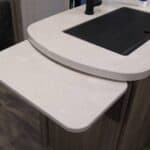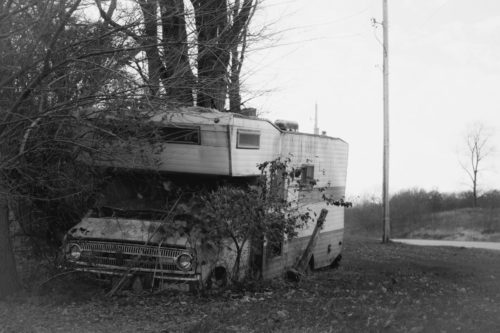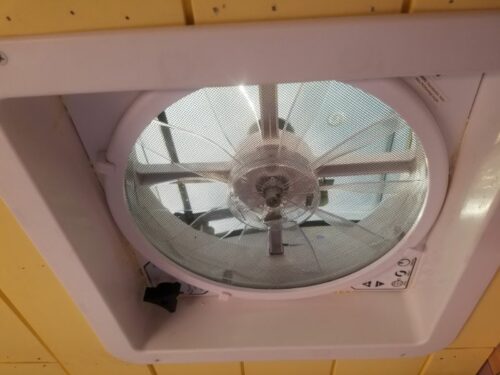Summer is fast approaching and it’s carrying plenty of heat in tow! If you’re just itching to hit the road in your RV, here are some options you need to consider when deciding how to keep your RV cool in the summer.
Your first thought is probably “air conditioning.” But with a little bit of planning, you can figure out effective ways to keep your RV cool without A/C. You can have tons of RV fun this hot weather season without breaking the bank!
By insulating your windows, ventilating your camper, parking in the shade, using LED lights and cleaning your A/C, you can enjoy the summer heat ensconced inside your RV.
1. PARK IN THE SHADE
The simplest and cheapest option is to just consider where you’re putting your RV when it’s time to get off the road. While it may seem obvious, being in the shade can make the temperature feel 10-15 degrees cooler.
Don’t just park where the shade is now; think about where the sun is going! Remember: the sun sets in the west. Getting into your RV campsite a bit earlier in the day can allow you a prime shaded spot. Kick your feet up and let everyone else sweat!
Hot Hint: A clean roof makes for a cool cabin! Dirty EPDM, TPO or PVC roofs absorb more heat than clean white roofs.
2. TAKE ADVANTAGE OF CROSS BREEZES
Just like with the first tip, finding a spot that allows the breeze to blow through your rig is going to make life a whole lot more comfortable. If you can find a shady spot with a cross-breeze, your experience will be infinitely more enjoyable.
Breezes normally occur in constricted valleys, on hillsides, and close to large bodies of water. Avoid dense, forested thickets, which block airflow.
Utilize screen doors if you have them. If not, consider installing a magnetic screen door to let the breeze in and keep the bugs out. If you have a roof vent, open that too. Open up windows on the opposite sides of your unit. The only thing you’ll want to be wary of is a skylight (we’ll talk about that in a minute!)
3. MAKE A HOME NEAR WATER
A simple way to beat the heat is to park your RV near a body of water. Not only is a lake or river a great way to cool off, but it’s also a lot of fun! Sure, you got your RV as a place to live on the road, but that doesn’t mean you want to spend all your time in it. Finding a water source breaks up the potential monotony of life in a camper and cools you down fast.
4. PLAN YOUR STOPS BASED ON WEATHER AND CLIMATE
“I’ll take ‘oversimplified’ for $500, Alex.”
If you don’t want to deal with heat in your RV, just head to cooler places! It sounds trite, but really there’s no better way to beat than by simply avoiding it altogether.
After a week in the desert of the southwestern US, a nice temperate coastal stop doesn’t sound all that bad. Especially if you’re heading up the west coast, why not start at the bottom and work your way north?
New Mexico, Arizona, and the Southern California desert are beautiful and have breathtaking sunrises and sunsets, but the triple-digit temperatures will get old no matter how much you relate to lizards.
Remember that dry air cools down faster than humid air, and higher elevations are cooler than lower elevations. Even in the desert Southwest, you can head to high ground for cooler temperatures.
Find spots on the beach or the bay and enjoy every moment of temperate luxury. You’ve earned it!
5. CONSIDER THE CLOTHING YOU’RE WEARING
While I’m sure you didn’t pack a parka for your summer travels, the fabric of your clothing is important. Not all short sleeve shirts and tank tops were made equal. Loose-fitting clothing in breathable fabrics is your best bet. Bonus points if they’re lighter colors too!
Yes, cotton keeps you cool by soaking up your sweat, but do you really want to be in a damp shirt all day? Consider polyester fabrics or even merino wool! You want a “wicking” material that wicks moisture away from your skin and lets it evaporate.
A hat and or a bandana to keep your head and neck cool will go a long way as well. Dunking your headwear in water is a tried n’ true camping hack, too!
6. CONSIDER WHAT YOU’RE EATING AND DRINKING
We’ve all been told to stay hydrated when it’s hot ever since childhood, but what does that actually mean?
First, and most obviously, you’ll want to continually be drinking water. If you sip water throughout your day you won’t have to chug large amounts later on to “catch up” and you won’t run into headaches or upset stomachs.
The rule of thumb for warmer weather is about 80 oz or 2.5 liters per day. You don’t need to take this as gospel, but it’s a good starting point for determining how much water you personally need. It might sound a little gross, but use the color of your urine to gauge your hydration. Pee never lies.
In terms of food, you want to make sure that you’re eating enough. Plain water passes quickly through the body without food in your stomach to slow it down. While eating enough is a good start, pay attention to how much salt you’re consuming.
On the other hand, you actually may not be getting enough salt! Salty snacks like pretzels are a great way to allow your body to hold onto more of the necessary water and not get dehydrated. Too much salt is unhealthy, but you may be constantly erring on the side of not enough. A quick alternative if you find yourself low on salt is an electrolyte-rich sports drink, like Gatorade, or adding electrolyte tablets to your water.
7. PLAN YOUR ACTIVITIES EFFICIENTLY
You got the RV to get away and see interesting things, so why not do that efficiently? If you can plan any indoor activities for during the heat of the day (this could be just getting lunch at a café or even buying groceries and souvenirs), you can have your creature comforts and not feel guilty about being indoors on a sunny day!
Drawing on the tip about looking for bodies of water, any activities that include ways to cool down (i.e., boating, rafting, or even visiting a unique water park) really net you two birds with one stone.
8. UPGRADE YOUR CEILING FAN
Most of the previous options were either free or at no extra cost. If you have your best linen outfit on in the shade and it’s still too toasty, maybe shell out some money for a few RV upgrades!
First up and a great budget option is getting a fan or two. With the windows open and the fan running, this man-made breeze will make short work of your RV’s warm, humid air. You can either use a portable 12V fan or upgrade your camper’s ceiling fan.
The ever-popular Fantastic Fan churns through up to 900 cubic feet per minute! That’s about 3x more than the typical low-budget RV fan.
If you have more than one such that you can draw in cool air and push out hot air, you’ll be reaching for a sweater before you know it.
9. GET SOME CURTAINS
A set of curtains or shades will be a big help in keeping your RV cool. If you’re worried about your RV’s insulation this summer, you have some options! It’s important to note that insulation doesn’t just mean heat retention. A good insulant will keep you cool in the summer and warm in the winter.
Blackout curtains are a great option here, especially for warm nights. Not only will it keep heat out, but the dark space will also make sleeping easier, even if your RV is a bit warmer than you may want. Shades are another option and can really upgrade the style of your interior if you find a pattern or color that you like.
For the more functional route, you can borrow a van-life/car camping staple and cut Reflectix to fit your windows. This can also be used to cover the skylight we talked about earlier (although you can also pick up skylight-specific covers). Reflectix works well to block the heat from getting in and provides great privacy to keep you and your RV covered this summer!
Just be careful! Reflectix covers and shades can, in direct summer sunlight, cause trap so much heat that plastic windows warp and glass windows crack!
10. THE BIG UMBRELLA
A trick my mother uses every sweltering summer: Umbrellas aren’t just for rain! Showers and sunshine, umbrellas keep you covered and comfortable. Consider a beach umbrella for maximum coverage, but a regular umbrella will to for a nice late afternoon walk.
11. ADD AN AWNING
If trees aren’t plentiful and you can’t stay in the RV any longer, an awning is a great middle ground. Why look for shade when you can just make it yourself? While awnings can be pricey, there are budget options as well as the DIY route that can get you some on-demand shade for under $200.
Awnings can be mounted using custom brackets to the roof or sidewall of your unit. Some flexible awnings even mount to a keder rail, a popular aluminum extrusion. Manual awnings are more affordable; automatic awnings are more expensive.
12. COOK OUTSIDE
You’ve got your awning all set up, so why cook inside? Cooking inside can quickly heat up your RV and there’s no reason to waste the sunshine outside and make yourself even sweatier at the same time.
While some teardrops and lower-priced options already come with outdoor kitchen setups, those of you with full-sized rigs can cook outside at a very attainable price point. While you can spend hundreds, even thousands, of dollars on an outdoor cooking setup, all you really need is a table and a propane stove. It’s likely that you already have a propane stove in your RV so all your cookware should be compatible.
If you happen to have an electric or induction setup, you should probably be fine as well. Your best bet is to find out the compatibility of your pots and pans ahead of time. Worst case scenario, you have to bring an extra pan for when you cook outside. I recommend a cast iron skillet in your arsenal for just this scenario!
13. REDUCE UNNECESSARY ELECTRONIC HEAT
Don’t unplug your fridge just yet! Sure, your fridge is a main heat source in your RV, but your phones, tablets, and TV create their fair share of heat as well. This is a great time to unplug anyway, so take advantage of it.
Of course, you need to keep at least one phone alive in case of emergency but being mindful of your electronic usage (especially if you’ve got the family with you) will keep your RV much more bearable. If parents and kids are all charging their devices at the same time, you’re just asking for your internal temperature to rise (and the RV’s!).
Hey, the reality may not be this simple but doing your best to cut back at least somewhat goes a long way.
14. CONSIDER YOUR LIGHTING
Switch out your fluorescent lightbulbs for LED bulbs. Not only will it save you money, but LEDS produce much less heat.
If you’re in the market already, lower Kelvin (3000-4000) bulbs that produce warmer, yellower light are more comfortable for the eyes. On long summer days, you aren’t using the lights as much anyway, so you can afford the lowered brightness. These warm bulbs produce a more orange light and can help you sleep.
On the other hand, higher Kelvin (4000-5500) bulbs produce a whiter light closer to genuine sunlight. They are better for detailed tasks like reading and cooking. Most people come with their own preferences.
Above all, pay attention to the brightness of your lights. If you have a dimmer switch, opt for lowered brightness. Installing one is also a great, affordable option if you don’t already have it. However, not all lightbulbs are compatible with a dimmer switch! Consult your manufacturer for more information.
15. KNOW WHEN TO USE A SWAMP COOLER
You’ve done all the previous steps and just aren’t fully comfortable. You want to be cooler but don’t want to run the AC. Those of us in hot dry climates have known this one for a long time: get a swamp cooler.
Also known as an evaporative cooler, a swamp cooler is a great way to stay comfortable in dry climates. I’m running mine as I write this! It’s a much more economical option, and if you’re coming from a humid area, you’ll be amazed at just what the swamp cooler is capable of when it comes to keeping your RV cool this summer.
But again: Only for hot, dry climates! Swamp coolers don’t work in muggy conditions. For more on this phenomenon, check out why I (Ross) hate portable air conditioners.
16. BE SAFE!
All the tips in the world don’t change the fact that you need to be aware of your body. If you’re coming from a cooler, more humid climate especially, heat stroke and heat exhaustion can sneak up on you. Even if you’re used to triple-digit temperatures, you aren’t immune to being casual about your health in the sun
While you may only have milder symptoms like headaches and tiredness, you still need to be vigilant. These minor symptoms can become dizziness, nausea, and fainting. At best it’s an inconvenience, at worst it’s a hospital trip.
You don’t want to derail the RV trip you’ve been so excited about and you definitely don’t want to end up needing medical attention. Luckily, if you’re aware and you follow these tips, you’ll have fun, safe (and cool!) RV trips this summer and for years to come.

Joseph Coleman
My background is in audio journalism and broadcast communications. I've lived in California, Alaska, and Washington in the last five years and done my fair share of traveling/outdoor activities in all of them!









